by Winding Pathways | Jul 12, 2018 | 1080 Labyrinth Blog, Nature, Travel/Columns, Wonderment
A Guest Blog by
Teri Petrzalek
Background Information:
Sunnylands is the 200-acre estate outside Palm Springs of Walter and Lenore Annenberg. In 2001 they created a trust fund to “address serious issues facing the nation and the world community.” A 25,000 square foot, Mid-Century marvel, this peaceful oasis is set in the center of a 9-hole golf course. The property is now used for retreats as well as high-level summits. Former President Obama met Chinese President Xi Jinping. Other dignitaries include the Reagans, Prince Charles and Margaret Thatcher. The work of the Foundation is committed to sustainability, Global Cooperation, Democratic Institutions and Global Health and Food Security.

A hint of Thyme.
A visitor center was constructed at the entry and with it several breath-taking garden vignettes. As we toured the gardens, the tree-lined path around the great lawn opened to a clearing which contained a labyrinth. The 7-circuit path was wide and separated by low plantings.
To finish reading this guest blog, go to 1080 Labyrinth of Recovery and Laughter.
by Winding Pathways | Jul 8, 2018 | Birds, Garden/Yard, Garden/Yard, Nature
This Nectar is TOOOO Hot! Ahh, Just Right!
Lijun Chadima, Guest blogger
Every year I always like to put the hummingbird feeder out as soon as the weather warms up. It’s been difficult this spring because of the crazy temperature fluctuations. Earlier this spring I was enjoying the warm sunshine on our porch when a beautiful ruby-throated hummingbird flew over and seemed to be wondering, “Where the heck is the feeder?” I boiled the sugar water that afternoon and hung out the feeder the next morning.
Mystery – Why No Hummingbirds?
After a couple days the level of the sugar water in the feeder didn’t appear to go down at all. My little friend stopped by a couple more times, but each time he flew off after just a brief sip. I went out to
check the feeder and discovered it was so hot that I could barely hold it in my hand. No wonder the hummingbirds weren’t drinking any! I suddenly remembered a bird show I saw on PBS that stated hummingbirds try to avoid extreme heat, so that afternoon I took the feeder down from its regular spot which was in direct sunlight, and moved it to a new location where it was in the shade under the sun umbrella.
Mystery Solved!
That apparently did the trick because the very next day multiple hummingbirds took turns drinking from the feeder.
Hummingbirds are a source of endless fascination for me. They are full of energy and dart around the sky in all directions like little helicopters. What a treat when one actually stops to rest on the ledge and enjoy a drink from the feeder. Just remember to keep it in the shade so it’s not too hot for them!
Click on the link below, download and watch the video by Lijun of the hummingbird happily sipping nectar in the shade.
by Winding Pathways | Jun 28, 2018 | Nature, Pests, Trees/Shrubs

Poison Ivy loves edges
This summer millions of Americans will have unhappy encounters with poison ivy. For most people, the result is a patch of itchy bumpy skin that goes away after a few days to a week or so. Unfortunate others will develop a serious reaction that includes severe itching and swelling.
The very best way to not get a case of poison ivy is to avoid the plant and its culprit – urushiol, an oil that causes the allergic reaction. It’s on the plant’s leaves, in the vines and the sap.
Avoiding urushiol is a surefire way of avoiding a poison ivy rash, but many people have trouble identifying the plant. Fortunately, poison ivy has a secret. Knowing it helps people avoid the plant.
Poison ivy is an amazingly adaptable, hardy and confusing plant. It can be a low growing ankle high sprig, a shoulder high shrub, or a vine winding up to the top of a tall tree. The old saying “Leaves of three, let them be” is only partially helpful in identifying the plant. Usually, it does have leaves in groups of three but many animals love dining on poison ivy and are immune to its ill effects. So, a rabbit or deer may have eaten a leaf, giving the plant leaves of two! And many nonpoisonous plants have leaves of three.
Enter the plant’s secret. Poison ivy is a plant of the edge. It’s rare in the middle of a sun-soaked prairie or in a deeply shaded forest. The plant almost always hugs the edge of a habitat, especially if it gets partial sunshine.

Birds drop seeds when they perch on campground posts.
We’ve seen poison ivy on the edges of:
- Lawns, including ours
- The ocean sand dunes
- Lakes, especially along trails
- Roads
- Trails anywhere
- Ballfields – the rough where balls sometimes go
- Picnic areas
- It especially seems to love life in state park campgrounds especially around the posts that mark a site number and the trees that shade a campground area and that kids love to hug!
So, to avoid poison ivy be especially cautious on the edge. Look carefully at edge plants and study photos of poison ivy in books and on the Internet. Avoid poison ivy when you can.
But, if you accidentally touch the plant or have been wading through likely habitat, get home soon, remove clothes carefully, avoiding touching the outsides of clothes where poison ivy sap may have touched, take a sudsy shower, toss the towels in the laundry, and odds are good that the oil will be soaped off before it creates an allergic reaction.
by Marion Patterson | Jun 21, 2018 | Geology/Weather, Nature, Reflections/Profiles, Wonderment
“Take Time. Make Time”
Guest Blogger
Connie Sjostrom

Sunrise comes early in Summer.
After working 40 years of my life, I was fortunate to be able to retire early. Always a multi-tasker while I was a working mom, you can imagine that much of my spare time was, well, not really spare. I vowed early on that my children should not miss out on “mom time” because I was working. That meant that some other things had to give a little. Like housework…that was easy
to cut. The only “extra time” I allowed myself before the family began to stir was a cup of coffee and a scan of the local paper WHILE I blow-dried my hair But getting back to my original point: when I retired, I knew it was going to take a bit to adjust to my new normal of no schedule. I developed two mantras –the first, “Slow Me Down, Lord”, and the second followed “Take time, make time.”
Like time to watch the sunrise.
Farm Life
Growing up on a farm I saw few sunrises mostly because I was already in the barn milking and there wasn’t a lot of extra time in those days. Milking 50 cattle morning and night…usually with only two people milking. You get the picture.

Arkansas Sunset
Photo by Connie Sjostrom
But, I saw lots of sunsets — mostly from a tractor. Back then we worked until it was dark, and sometimes later depending on the season. Still no camera handy. And if I did get a shot, I had to wait until the roll was full to get it developed. And usually, a few weeks for it to come back not to mention the trip to town to drop it off and pick it up. It was a real thing.
Commute
When we first married my husband and I enjoyed small town living but that involved a 45-minute commute to work and little extra time to catch the sunrise. Even when we moved to the country 27 years ago, I was still up early and getting ready for my day. We had the perfect spot — on top of a hill facing East-southeast. But until I retired I was hit and miss on taking the time to actually catch the sunrise. And then, I didn’t always have a camera at the ready, so very few were ever captured.
Fast forward to my retirement years. I now have hundreds (maybe thousands) of pictures of sunrises and I am so glad I can share those with others who may not have the time or the perfect location to view these masterpieces of creation. While Facebook has its drawbacks, being able to share a sunrise photo instantly is definitely a plus.
Sunrise this time of year is @ 5:30 a.m. Take time, make time!
-

-
Along tree line.
Photo by Connie Sjostrom
-

-
Sunrise along fence.
Photo by Connie Sjostrom
-

-
Sun shinning on snow.
Photo by Connie Sjostrom
-

-
Blue tints as sun rises.
Photo by Connie Sjostrom
by Winding Pathways | Jun 7, 2018 | (Sub)Urban Homesteading, Birds, Garden/Yard, Nature
Birding in our Back Yard
We’ve traveled throughout the United States seeking interesting birds, and we just discovered the very best place.
It’s our backyard! Since we began actively diversifying the plants in our yard they’ve welcomed many new bird species to visit, rest, and eat. And, we live next to Faulke’s Heritage Woods, a 110 acres of shrubs and old trees that is a warbler and woodpecker haven.
Anyone who plants an array of bushes and grasses in their yard, even if it’s a tiny yard, can enjoy birding at home. Planting appropriate shrubs, mainly native species is important because some shrubs like barberry are invasive and crowd out beneficial plants.
Because the yard is right out the door, it is an easy place to grab the binoculars and a glass of wine or cup of tea and sit quietly.
Here’s what we’ve seen or heard in our yard in the past two weeks:
The winter birds left quietly – juncos and siskins. And, on their heels arrived the migrants.
Resident and Migratory Birds
Warblers: Black-Throated Green, Tennessee, Blackpoll, Cerulean, Yellow, Yellow-Rumped, and Redstart
Woodpeckers: Pileated, Hairy, Downy, Red Bellied, Red Headed, and Flicker. Earlier in the year, we saw the telltale evidence of the elusive sapsucker – wells drilled horizontally in sap filled trees.
Others: Bluebird, Cowbird, White Crowned and White Throated Sparrow, Chipping Sparrow, House Sparrow, Starling, Turkey, Crows, Vulture, Cooper’s Hawk, Barred and Horned Owls, Eagles, Chickadee, Nuthatch, Brown Creeper, House Wren, Titmouse, Goldfinch, House Finch, Robin, Wild Turkey, Hummingbird, Oriole, Rose-breasted Grosbeak, Indigo Bunting and a Wood Duck winging overhead. Additionally, Canada geese and pelicans have flown over on their way to ponds and lakes.
Recently Rich and a friend hiked to Hanging Rock in Effigy Mounds National Monument in northeast Iowa. They birded on the seven-mile walk. It was outstanding and spotted many species. But, not as many as we’ve seen sitting in our own backyard!
Winding Pathways encourages people to diversify the plants in their yards to create truly wondrous places that birds love. It can be the best place in the world to enjoy them.
-
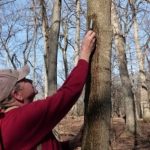
-
Rich points to horizontal holes of sapsucker.
-
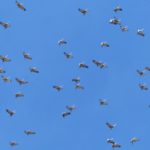
-
Winging Overhead.
-
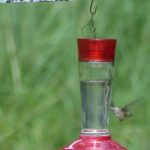
-
Getting nectar.
-
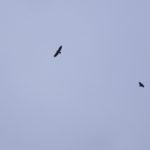
-
Two eagles in sky
-
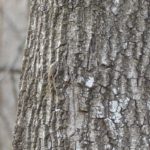
-
A camouflaged creeper on tree trunk.
-
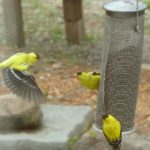
-
Iowa’s state bird
-
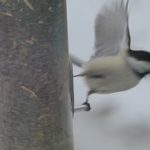
-
The cheerful denizens of open woods.
-
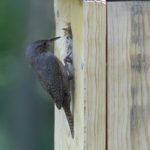
-
Checking out a birdhouse
-
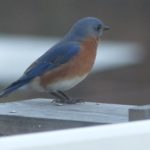
-
Male bluebird.
-
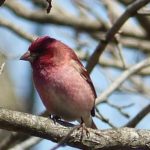
-
On a branch
by Winding Pathways | May 31, 2018 | Birds, Nature
Reflecting on Heron Rookeries
Guest blog by Sigrid Reynolds
Heron rookeries are one of the most peculiar sights you will see.
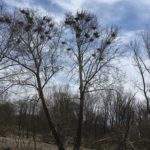
Photo by Sigrid Reynolds
Picture three large sycamore trees in the middle of a swamp in Ohio. Skunk cabbages, those harbingers of spring, poke up along the early pioneer road that crosses these wetlands. One narrow parking spot across the street hosts cars and vans while up to 20 nature lovers with binoculars and huge camera lenses stand on the shoulder across the street. Clacking, clicking sounds pulse from the trees that host more than a score of messy stick nests. About half of them have great blue heron silhouettes standing sentry nearby. By late April, fluffy chicks poke their heads up from under a parent. And, by June, the adolescent chicks, now the size of their parents, still demand food.
Hmmm, one’s mind drifts to adolescent humans taking over home acreage while ravenously emptying the fridge.
Great Access
This heron rookery between Cleveland and Akron, Ohio, has sheltered generations of great blue herons and has delighted visitors to the Cuyahoga Valley National Park every Spring. Rookeries abound across the US but few are as accessible as this one, less than eight miles off I-80. Along the same interstate in the Indiana Dunes, is an enormous rookery of up to 98 mating pairs. It is closed to visitors during nesting season.
Herons return each year (as do the nature photographers) and re-inhabit their nests, adding more limbs and sticks as needed. One year in a Nebraska swamp, herons arrived to find an eagle pair has appropriated their home.
Squatters
Eagles nest earlier than herons and find that their nest makes the perfect platform for more sticks. A tussle seems to go on between these two large species of birds. YouTube has intriguing videos of eagles vs. herons. Here is an amazing one. Usually, eagle activity won’t drive the herons away but does cause turmoil.
Human endeavors do drive off herons. When wetlands are drained for subdivisions, the amphibians and fish that feed herons disappear. So, these magnificent birds must seek a landscape that can sustain them and their hungry families.
Our parks and nature preserves protect these nesting sites so that we can continue to see the solitary visitors we welcome to our neighborhood ponds and creeks. I’m grateful for these preserves every time I sit on my back patio watching “our” heron arrive. He lands on a branch of my neighbor’s big pine to peruse food possibilities before he heads down to the shores of the small pond that marks our property line.
-
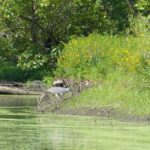
-
A Heron waits patiently for a fish.
-
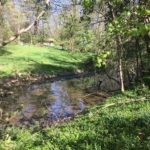
-
Small pond in back yard.






















